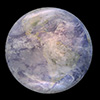| Jun 21, 2023 |
|
|
|
(Nanowerk News) How close can a rocky planet be to a star, and still sustain water and life?
|
|
A recently discovered exoplanet may be key to solving that mystery, providing important insights about conditions at the inner edge of a star’s habitable zone and why Earth and Venus developed so differently, according to new research led by Lisa Kaltenegger, director of the Carl Sagan Institute and associate professor of astronomy in the College of Arts and Sciences (A&S).
|
|
Kaltenegger’s team found that the “super-Earth” LP 890-9c (also named SPECULOOS-2c), which orbits close to the inner edge of its solar system’s habitable zone, would look very different depending on whether it still had warm oceans, a steam atmosphere or if it had lost its water, assuming it once had oceans like Earth’s.
|
|
“Looking at this planet will tell us what’s happening on this inner edge of the habitable zone – how long a rocky planet can maintain habitability when it starts to get hot,” Kaltenegger said. “It will teach us something fundamental about how rocky planets evolve with increasing starlight, and about what will one day happen to us and Earth.”
|
 |
| Artist impression showing the exoplanet LP 890-9c’s potential evolution from a hot Earth to a desiccated Venus. (Image: Carl Sagan Institute/R. Payne)
|
|
Kaltenegger is the lead author of a paper published in Monthly Notices of the Royal Astronomical Society: Letters (“Hot Earth or Young Venus? A Nearby Transiting Rocky Planet Mystery”). Co-authors are Rebecca Payne, research associate in the Department of Astronomy (A&S); Zifan Lin ’20, doctoral student at the Massachusetts Institute of Technology; James Kasting, professor emeritus at Pennsylvania State University; and Laetitia Delrez, postdoctoral researcher at the University of Liège in Belgium, who led an international team that reported the discovery of LP 890-9c in September 2022.
|
|
A companion paper (Monthly Notices of the Royal Astronomical Society: Letters, “A Venus in the Making? Predictions for JWST Observations of the Ultracool M-Dwarf Planet LP 890-9c”) led by Jonathan Gomez Barrientos ’22, a graduate student at the California Institute of Technology, demonstrates that NASA’s James Webb Space Telescope (JWST) could distinguish between the exoplanet’s potential different atmospheres, making it a prime target for the flagship observatory. Kaltenegger is a co-author with Ryan J. MacDonald, a former research associate at Cornell and now a NASA Sagan Fellow at the University of Michigan.
|
|
LP 890-9c is one of two super-Earths orbiting a red dwarf star located 100 light years from Earth, the Delrez team – which included Kaltenegger – announced last year. (NASA’s Transiting Exoplanet Survey Satellite had previously identified LP 890-9b.) They said liquid water or an atmosphere rich in water vapor was possible on LP 890-9c, which is about 40% larger than Earth and circles the small, cool star in 8.5 days.
|
|
Those criteria suggested it to be one of the best targets for JWST to study among the known, potentially habitable terrestrial planets, in addition to the TRAPPIST-1 system.
|
|
“Professor Kaltenegger and I were thinking this exoplanet might be an excellent target for JWST,” Barrientos said, “but now we’ve proven this hypothesis, and that LP 890-9c may potentially reveal if life is possible on the edge – the inner edge of the habitable zone.”
|
|
Her team’s models are the first to detail differences in the chemical signatures generated by rocky planets near the habitable zone’s interior boundary, based on variables including the planet’s size, mass, chemical makeup, surface temperature and pressure, atmospheric height and cloud cover. The calculations were key to estimating how much time JWST would need to confirm the basic composition of an atmosphere – if there is one.
|
|
The models span several scenarios thought to reflect stages of rocky planets’ evolution, ranging from a “hot Earth” where life might still be possible, to a desolate Venus featuring a carbon dioxide atmosphere. In between are phases Earth is expected to experience as the sun grows brighter and hotter with age, causing the oceans to gradually evaporate and fill the atmosphere with steam before boiling off entirely.
|
|
How long those processes might take is unknown, and the astronomers say LP 890-9c provides a rare opportunity to explore that evolution.
|
|
“This planet is the first target where we can test these different scenarios,” Kaltenegger said. “If it’s still a hotter Earth – hot, but with liquid water and conditions for life – then the inner edge of the habitable zone could be teeming with life. If we see that it’s already a full-blown Venus, then water can get lost faster than we anticipate.”
|
|
In the companion paper, Kaltenegger and colleagues propose that JWST could confirm the presence of an atmosphere – and whether it is primarily water vapor – in as few as three transits, or passages of the planet across its host star. If further observation is warranted, they estimate a total of eight transits could detect a Venus-like atmosphere, while 20 transits could find evidence of a potentially habitable “hot Earth” scenario.
|
|
It’s possible that LP 890-9c has no atmosphere and hosts no life, or that it resembles a Venus with thick clouds that would block light from reflecting and thus yield little information. Deeper investigation promises to provide valuable clues, Kaltenegger said.
|
|
“We don’t know what this planet on the edge of habitability could be like, so we have to look,” she said. “This is what real exploration is about.”
|


